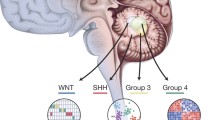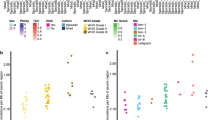Abstract
Recent sequencing efforts have described the mutational landscape of the pediatric brain tumor medulloblastoma. Although MLL2 is among the most frequent somatic single nucleotide variants (SNV), the clinical and biological significance of these mutations remains uncharacterized. Through targeted re-sequencing, we identified mutations of MLL2 in 8 % (14/175) of MBs, the majority of which were loss of function. Notably, we also report mutations affecting the MLL2-binding partner KDM6A, in 4 % (7/175) of tumors. While MLL2 mutations were independent of age, gender, histological subtype, M-stage or molecular subgroup, KDM6A mutations were most commonly identified in Group 4 MBs, and were mutually exclusive with MLL2 mutations. Immunohistochemical staining for H3K4me3 and H3K27me3, the chromatin effectors of MLL2 and KDM6A activity, respectively, demonstrated alterations of the histone code in 24 % (53/220) of MBs across all subgroups. Correlating these MLL2- and KDM6A-driven histone marks with prognosis, we identified populations of MB with improved (K4+/K27−) and dismal (K4−/K27−) outcomes, observed primarily within Group 3 and 4 MBs. Group 3 and 4 MBs demonstrate somatic copy number aberrations, and transcriptional profiles that converge on modifiers of H3K27-methylation (EZH2, KDM6A, KDM6B), leading to silencing of PRC2-target genes. As PRC2-mediated aberrant methylation of H3K27 has recently been targeted for therapy in other diseases, it represents an actionable target for a substantial percentage of medulloblastoma patients with aggressive forms of the disease.





Similar content being viewed by others
References
Alimova I, Venkataraman S, Harris P, Marquez VE, Northcott PA (2012) Targeting the enhancer of zeste homologue 2 in medulloblastoma. Int J Cancer doi:10.1002/ijc.27455
Andreu-Vieyra CV, Chen R, Agno JE, Glaser S, Anastassiadis K et al (2010) MLL2 is required in oocytes for bulk histone 3 lysine 4 trimethylation and transcriptional silencing. PLoS Biol 8(8):e1000453
Bots M, Johnstone RW (2009) Rational combinations using HDAC inhibitors. Clin Cancer Res 15(12):3970–3977
Ecke I, Petry F, Rosenberger A, Tauber S, Monkemeyer S et al (2009) Antitumor effects of a combined 5-aza-2′deoxycytidine and valproic acid treatment on rhabdomyosarcoma and medulloblastoma in Ptch mutant mice. Cancer Res 69(3):887–895
Ellison DW, Onilude OE, Lindsey JC, Lusher ME, Weston CL et al (2005) beta-Catenin status predicts a favorable outcome in childhood medulloblastoma: the United Kingdom Children’s Cancer Study Group Brain Tumour Committee. J Clin Oncol 23(31):7951–7957
Fejes AP, Khodabakhshi AH, Birol I, Jones SJ (2011) Human variation database: an open-source database template for genomic discovery. Bioinformatics 27(8):1155–1156
Glaser S, Schaft J, Lubitz S, Vintersten K, van der Hoeven F et al (2006) Multiple epigenetic maintenance factors implicated by the loss of Mll2 in mouse development. Development 133(8):1423–1432
van Haaften G, Dalgliesh GH, Davies H, Chen L, Bignell G et al (2009) Somatic mutations of the histone H3K27 demethylase gene UTX in human cancer. Nat Genet 41(5):521–523
Jones DT, Jager N, Kool M, Zichner T, Hutter B et al (2012) Dissecting the genomic complexity underlying medulloblastoma. Nature 488(7409):100–105
Kool M, Koster J, Bunt J, Hasselt NE, Lakeman A et al (2008) Integrated genomics identifies five medulloblastoma subtypes with distinct genetic profiles, pathway signatures and clinicopathological features. PloS One 3(8):e3088
Kool M, Korshunov A, Remke M, Jones DT, Schlanstein M et al (2012) Molecular subgroups of medulloblastoma: an international meta-analysis of transcriptome, genetic aberrations, and clinical data of WNT, SHH, Group 3, and Group 4 medulloblastomas. Acta Neuropathol 123(4):473–484
Lafay-Cousin L, Bouffet E, Hawkins C, Amid A, Huang A et al (2009) Impact of radiation avoidance on survival and neurocognitive outcome in infant medulloblastoma. Curr Oncol 16(6):21–28
McCabe MT, Ott HM, Ganji G, Korenchuk S, Thompson C, et al (2012) EZH2 inhibition as a therapeutic strategy for lymphoma with EZH2-activating mutations. Nature. doi:10.1038/nature11606
Morin RD, Mendez-Lago M, Mungall AJ, Goya R, Mungall KL et al (2011) Frequent mutation of histone-modifying genes in non-Hodgkin lymphoma. Nature 476(7360):298–303
Northcott PA, Korshunov A, Witt H, Hielscher T, Eberhart CG et al (2011) Medulloblastoma comprises four distinct molecular variants. J Clin Oncol 29(11):1408–1414
Northcott PA, Nakahara Y, Wu X, Feuk L, Ellison DW et al (2009) Multiple recurrent genetic events converge on control of histone lysine methylation in medulloblastoma. Nat Genet 41(4):465–472
Parsons DW, Li M, Zhang X, Jones S, Leary RJ et al (2011) The genetic landscape of the childhood cancer medulloblastoma. Science 331(6016):435–439
Pfaff E, Remke M, Sturm D, Benner A, Witt H et al (2010) TP53 mutation is frequently associated with CTNNB1 mutation or MYCN amplification and is compatible with long-term survival in medulloblastoma. J Clin Oncol 28(35):5188–5196
Pugh TJ, Weeraratne SD, Archer TC, Pomeranz Krummel DA, Auclair D et al (2012) Medulloblastoma exome sequencing uncovers subtype-specific somatic mutations. Nature 488(7409):106–110
Robinson G, Parker M, Kranenburg TA, Lu C, Chen X et al (2012) Novel mutations target distinct subgroups of medulloblastoma. Nature 488(7409):43–48
Rudin CM, Hann CL, Laterra J, Yauch RL, Callahan CA et al (2009) Treatment of medulloblastoma with hedgehog pathway inhibitor GDC-0449. N Engl J Med 361(12):1173–1178
Schuettengruber B, Chourrout D, Vervoort M, Leblanc B, Cavalli G (2007) Genome regulation by polycomb and trithorax proteins. Cell 128(4):735–745
Schuettengruber B, Martinez AM, Iovino N, Cavalli G (2011) Trithorax group proteins: switching genes on and keeping them active. Nat Rev Mol Cell Biol 12(12):799–814
Tamayo P, Cho YJ, Tsherniak A, Greulich H, Ambrogio L et al (2011) Predicting relapse in patients with medulloblastoma by integrating evidence from clinical and genomic features. J Clin Oncol 29(11):1415–1423
Taylor MD, Northcott PA, Korshunov A, Remke M, Cho YJ et al (2012) Molecular subgroups of medulloblastoma: the current consensus. Acta Neuropathol 123(4):465–472
Acknowledgments
MDT is supported by a CIHR Clinician Scientist Phase II award. MDT and WW are supported by a grant from the National Institutes of Health (R01CA148699) and from The Pediatric Brain Tumor Foundation. Marc Remke is funded by the Mildred-Scheel Foundation/German Cancer Aid. We thank Susan Archer for assistance with technical writing.
Author information
Authors and Affiliations
Corresponding author
Electronic supplementary material
Below is the link to the electronic supplementary material.
401_2012_1070_MOESM4_ESM.eps
Supplementary material 4 Supplementary Fig. 1. Bioinformatic workflow used to discover and verify the presence of MLL2 and KDM6A mutations across 175 primary medulloblastomas. Mutations were inferred using SNVmix2 and SamTools INDEL detection metrics. Mutations, following filtering through SNP databases, were verified using Sanger sequencing. (EPS 1,312 kb)
401_2012_1070_MOESM5_ESM.eps
Supplementary material 5 Supplementary Fig. 2. Molecular characteristics of MLL2 expression, copy number and mutational analysis across multiple medulloblastomas cohorts. a, Subgroup-specific analysis of clonal and subclonal MLL2 mutations, based on sequence reads for wild-type and mutated alleles, reveals no homozygous MLL2 mutations. b, Sanger sequencing validation of representative MLL2 mutations, with corresponding read (wild-type versus mutated) counts. c, Frequency of MLL2 mutations per tumor genome across medulloblastoma discovery and validation cohorts demonstrates only SHH tumors have > 1 MLL2 mutation/genome. d, Expression analysis across two independent transcriptome cohorts indicates reduced MLL2 expression in WNT and SHH tumors and relatively higher expression in Group3 and Group 4 medulloblastomas. e, Copy number analysis of MLL2 genomic loci (chr12q13.12) across 201 primary medulloblastomas profiled on Affymterix 100 K and 500 K SNP arrays reveals no copy number alterations (i.e., deletions, 1.5 < MLL2 CN > 2.75). (EPS 4,778 kb)
401_2012_1070_MOESM6_ESM.eps
Supplementary material 6 Supplementary Fig. 3. Clinical characteristics of medulloblastomas with MLL2 mutations or MLL2 immunonegativity. a, Kaplan–Meier analysis of MLL2 mutations across 175 primary medulloblastomas reveals no significant (P < 0.80) difference in overall survival associated with MLL2 mutations. b, Kaplan–Meier survival analysis of MLL2 immunohistochemical staining across 239 medulloblastomas reveals no significant (P < 0.41) subgroup-independent survival differences between positively and negatively staining samples. (EPS 1,121 kb)
401_2012_1070_MOESM7_ESM.eps
Supplementary material 7 Supplementary Fig. 4. KDM6A mutational and expression characteristics across medulloblastomas cohorts. a, Subgroup-specific analysis of clonal and subclonal KDM6A mutations, based on sequence reads for wild-type and mutated alleles, reveals exclusively homozygous deletions in Group 4 medulloblastomas while SHH and Group 3 tumors demonstrate subclonal and heterozygous read frequencies. b, KDM6A gene expression profiling analysis across Toronto (n = 103) and Heidelberg (n = 302) medulloblastoma datasets reveals similar trends in expression with SHH tumors demonstrating the highest expression patterns. (EPS 2,467 kb)
401_2012_1070_MOESM8_ESM.eps
Supplementary material 8 Supplementary Fig. 5. Immunostaining for MLL2- and KDM6A-driven histone marks, H3K4me3 and H3K27me3 across medulloblastoma tissue microarrays. a, H3K4me3 staining patterns across Johns Hopkins and DKFZ tissue microarrays reveals no significant association between H3K4me3 positivity versus negativity with overall survival. Both arrays demonstrate trends towards decreased survival associated with H3K4me3-negativity. b, H3K27me3 immunostaining across Johns Hopkins and DKFZ tissue microarrays reveals no significant association between H3K27mme3 positivity versus negativity with overall survival. (EPS 9,357 kb)
401_2012_1070_MOESM9_ESM.eps
Supplementary material 9 Supplementary Fig. 6. Copy number and expression analysis of cytogenetic aberrations converging on H3K27me-modifiers across the medulloblastoma genome. a, Significant correlation between copy number and expression of EZH2 in both a subgroup-independent and dependent analyses. b, While KDM6A and KDM6B demonstrates trends towards chrX loss (KDM6A) or chr17p loss (KDM6B) and reduced expression in a subgroup dependent manner. (EPS 3,063 kb)
Rights and permissions
About this article
Cite this article
Dubuc, A.M., Remke, M., Korshunov, A. et al. Aberrant patterns of H3K4 and H3K27 histone lysine methylation occur across subgroups in medulloblastoma. Acta Neuropathol 125, 373–384 (2013). https://doi.org/10.1007/s00401-012-1070-9
Received:
Revised:
Accepted:
Published:
Issue Date:
DOI: https://doi.org/10.1007/s00401-012-1070-9




